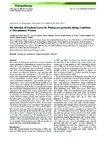Use este identificador para citar ou linkar para este item:
http://www.alice.cnptia.embrapa.br/alice/handle/doc/877741Registro completo de metadados
| Campo DC | Valor | Idioma |
|---|---|---|
| dc.contributor.author | FURTADO, G. Q. | pt_BR |
| dc.contributor.author | MORAES, S. R. G. | pt_BR |
| dc.contributor.author | ALVES, S. A. M. | pt_BR |
| dc.contributor.author | AMORIM, L. | pt_BR |
| dc.contributor.author | MASSOLA JUNIOR, N. S. | pt_BR |
| dc.date.accessioned | 2016-10-25T21:35:47Z | - |
| dc.date.available | 2016-10-25T21:35:47Z | - |
| dc.date.created | 2011-02-17 | pt_BR |
| dc.date.issued | 2011 | pt_BR |
| dc.identifier.citation | Journal of Phytopathology, Berlin, v. 159, n. 3, p. 165-170, mar. 2011. | pt_BR |
| dc.identifier.uri | http://www.alice.cnptia.embrapa.br/alice/handle/doc/877741 | pt_BR |
| dc.description | The ability of Phakopsora pachyrhizi to cause infection under conditions of discontinuous wetness was investigated. In in vitro experiments, droplets of a uredospore suspension were deposited onto the surface of polystyrene. After an initial wetting period of either 1, 2 or 4 h, the drops were dried for different time intervals and then the wetness was restored for 11, 10 or 8 h. Germination and appressorium formation were evaluated. In in vivo experiments, soybean plants were inoculated with a uredospore suspension. Leaf wetness was interrupted for 1, 3 or 6 h after initial wetting periods of 1, 2 or 4 h. Then, the wetting was re-established for 11, 10 or 8 h, respectively. Rust severity was evaluated 14 days after inoculation. The germination of the spores and the formation of the appressoria on the soybean leaves after different periods of wetness were also quantified in vivo by scanning electron microscopy. P. pachyrhizi showed a high infective capacity during short periods of time. An interruption of wetness after 1 h caused average reductions in germination from 56 to 75% and in appressorium formation from 84 to 96%. Rust severity was lower in all of the in vivo treatments with discontinuous wetness when compared to the control plants. Rust severity was zero when the interruption of wetness occurred 4 h after the initial wetting. Wetting interruptions after 1 and 2 h reduced the average rust severity by 83 and 77%, respectively. The germination of the uredospores on the soybean leaves occurred after 2 h of wetness, with a maximum germination appearing after 4 h of wetness. Wetness interruption affected mainly the spores that had initiated the germination. | pt_BR |
| dc.language.iso | eng | eng |
| dc.rights | openAccess | eng |
| dc.title | The infection of soybean leaves by Phakopsora pachyrhizi during conditions of discontinuous wetness. | pt_BR |
| dc.type | Artigo de periódico | pt_BR |
| dc.date.updated | 2019-05-20T11:11:11Z | pt_BR |
| dc.subject.thesagro | Soja | pt_BR |
| dc.subject.thesagro | Doença de planta | pt_BR |
| dc.subject.thesagro | Ferrugem | pt_BR |
| dc.subject.thesagro | Fungo | pt_BR |
| dc.subject.thesagro | Umidade | pt_BR |
| dc.subject.thesagro | Folha | pt_BR |
| dc.format.extent2 | 165-170 | eng |
| riaa.ainfo.id | 877741 | pt_BR |
| riaa.ainfo.lastupdate | 2019-05-20 -03:00:00 | pt_BR |
| dc.identifier.doi | 10.1111/j.1439-0434.2010.01742.x | pt_BR |
| dc.contributor.institution | GLEIBER QUINTÃO FURTADO, UFV; SYLVIA RAQUEL GOMES MORAES, ESALQ/USP; SILVIO ANDRE MEIRELLES ALVES, CNPUV; LILIAN AMORIM, UFV; NELSON SIDNEI MASSOLA JUNIOR, UFV. | pt_BR |
| Aparece nas coleções: | Artigo em periódico indexado (CNPUV)  | |
Arquivos associados a este item:
| Arquivo | Descrição | Tamanho | Formato | |
|---|---|---|---|---|
| SILVIOJPhytopatholv159p1652011.pdf | 429.64 kB | Adobe PDF |  Visualizar/Abrir |









